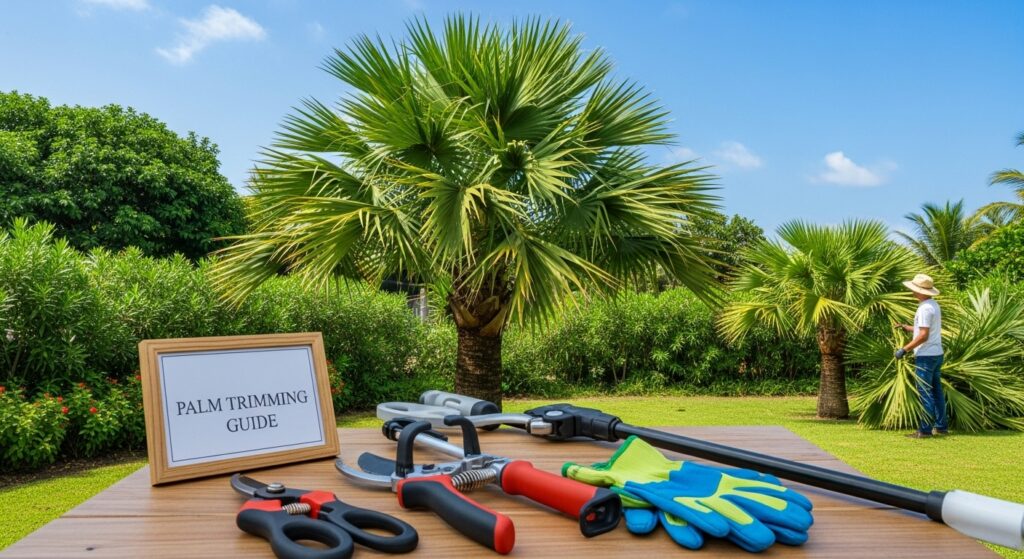Introduction
Palm trees stand out as beautiful symbols of tropical areas, but keeping them in good shape means trimming them. Whether you have one tree in your yard, a rooftop palm in a city setting, or an entire collection of palms to manage, it’s important to understand the best ways and times to trim. This guide will walk you through why trimming is needed, a clear step-by-step process, helpful tips, and how to locate local trimming services.
The Importance of Palm Tree Trimming
Trimming benefits go beyond just making a tree look good. It helps to:
- Cut off dead or sick fronds to stop diseases from spreading.
- Eliminate dangers like falling branches and fire threats.
- Help the tree grow stronger and produce more fruit.
- Clear out old leaves to keep rodents and bugs from nesting.
- Make your property look neater and more attractive.
- Let rooftop gardens get more air and light.
- Keep urban spaces and commercial areas easy to see and access.
Trimming the right way also helps keep structures safe. This is true in tall buildings where wind and debris can create problems.
Best Time to Trim Palm Trees?
The best time to cut palm trees comes in spring or early summer when the weather helps the tree heal and grow. Trimming in winter in cold areas can harm the tree and stress it out.
When You Should Trim a Palm Tree:
- Fronds are yellow, brown, or dead.
- Fronds hang too low near the ground or the roof.
- Growth blocks paths, solar panels, or buildings.
- Old fronds have pests like insects or rodents nesting.
What You’ll Need to Trim a Palm Tree
To trim a palm tree well and avoid injuries, you need the right tools and safety gear:
Tools:
- Use bypass pruning shears to trim small fronds.
- Use loppers to cut medium-sized fronds.
- Turn to a hand saw or bow saw when dealing with thicker fronds.
- Opt for a pole saw or tree pruner to reach tall trees.
- Grab a chainsaw to handle very large fronds or to clean trunks.
Safety Gear:
- Wear gloves to protect your hands.
- Use goggles to keep your eyes safe.
- Put on a long-sleeved shirt and tough pants.
- Wear a helmet if you are working with tall ladders or on a rooftop.
- Make sure to use boots that don’t slip.
- Secure a harness and rope if you are using a ladder or working on the roof.
Extra Tips:
- Clean tools both before and after use to stop the spread of disease.
- Team up with someone if you can when working at heights.
- Place ladders on steady surfaces or make sure they are secured when used on rooftops.
Steps to Trim a Palm Tree
- Get Your Equipment Ready: Pick the tools and gear suited to the tree’s size and where it’s located.
- Check the Tree Carefully: Spot fronds that are dead, damaged, or hanging. Look out for flower stalks and seed pods too.
- Find a Safe Cutting Angle: Position yourself so you can cut each frond close to the base without causing harm to the trunk.
- Take Out Unhealthy Parts: Focus on getting rid of fronds that are yellow, brown, or dead, but leave the green ones to keep the tree healthy.
- Work in Steps with Tall Trees: If the tree is tall, trim it from the bottom up in smaller sections you can handle.
- Remove Fruit Stalks and Seeds: These bring in pests and take energy away from the tree.
- Get Rid of Debris: Clean up any trimmings and fallen pieces right away.
- Sanitize Tools: Use alcohol to wipe tool blades and stop the spread of diseases.
Quick Tip: Avoid trimming palm trees into a “hurricane cut.” Taking off too many fronds makes the tree weaker and easier for the wind to damage.
Common Errors People Make
- Cutting too many branches: This can make the palm weaker and open the door for pests.
- Using unclean tools: This spreads tree diseases that can harm it.
- Taking off green fronds: This reduces the tree’s ability to get energy through photosynthesis.
- Pruning in the wrong season: This can put stress on the tree or make it heal more slowly.
- Skimming on safety near rooftops: Always use steady ladders and safety gear when working at a height.
- Overlooking pests or decay: Delaying necessary trimming can risk the tree’s health.
Go DIY or Hire an Expert?
Reasons to Try DIY:
- You can cut costs.
- You control how everything gets done.
- You choose the time to tackle it.
What Could Go Wrong:
- Using tools wrong or falling could cause injuries.
- Damaging the tree is a real risk.
- Tall palms might be out of reach.
- Working from rooftops is risky.
- Pruning the wrong way can ruin how the tree grows.
When to Search “Palm Tree Trimming Near Me”:
- If the tree is over 20 feet tall.
- When certain spots are tough to get to.
- To handle pests or tree diseases.
- If rooftops require special gear to access.
Common Costs:
- Small trees cost between $75 and $150
- Medium trees range from $150 to $300
- Large trees start at $300 and can go up to $600 or more
Palm Tree Trimming Schedule
- Queen Palm: You should trim these every 12 to 18 months.
- King Palm: This type requires regular trimming.
- Canary Island Date Palm: Prune these once every 1 to 2 years.
Palms grown in containers or placed on rooftops often need more care. You might need to check them more often and trim them. Limited space and unique growing conditions call for this. Trimming and growth depend on factors like light, humidity, and wind exposure.
Reasons Palm Trees Suit Rooftop Gardens
Palm trees are a smart choice for rooftop gardens because they:
- Create a tropical vibe and give natural shade
- Grow tall without spreading out, which saves room
- Stand up to the wind and fit well in urban areas
- Lower rooftop heat reduces energy use
- Improve building appearances and raise property value
- Attract birds and useful bugs to boost city biodiversity
- Require less care compared to wide-leaf trees
Compact palms like the Pygmy Date Palm or the Areca Palm are great for rooftop container gardens. These palms are simple to care for, adapt well to city weather, and enhance green building designs.
How Palm Trees Affect the Environment
Eco-conscious palm pruning encourages:
- Cooling cities: Healthy trees keep cities cooler by reducing heat in busy areas.
- Cleaning the air: Trees absorb carbon dioxide and release oxygen into the air.
- Managing stormwater: Potted palms on rooftops help reduce water runoff.
- Helping wildlife: Well-maintained palms provide shelter to birds, insects, and other pollinators.
Avoid using chemical sprays or too much fertilizer. Use composted mulch or natural soil enhancers to create green and thriving rooftop gardens.
How to Find Reliable Palm Tree Trimming Services Nearby
Tips to search:
- Search “palm tree trimming near me” on Google.
- Check reviews on sites like Yelp or Angie’s List, and browse local Facebook groups.
- Ask for proof of their license, insurance, and references from previous clients.
Things to Ask:
- Do you clean and sterilize your tools?
- How do you handle getting rid of the trimmed fronds?
- Is your team insured against property damage?
- Have you worked on rooftop trimming jobs earlier?
- Can you show photos or reviews from past jobs?
Common Questions
Q1: Is it safe to use a chainsaw on palm trees?
A: You can use it to cut bigger fronds or clean up the trunk. Just stay careful and use it if you are confident and know how to handle it.
Q2: Should I get rid of flower stalks and seeds?
A: Yes, removing them is good because they use up energy and might attract pests.
Q3: Can palm trees be trimmed in winter?
A: Cut them in winter if it is necessary to prevent danger or damage.
Q4: What is the best way to trim a tall palm tree?
A: Either use a pole saw or hire professionals to do the job if the tree is close to a roof.
Q5: Do I need to trim palm trees every year?
A: No, you do not. Check what kind of palm tree you have, how it grows, and how healthy it is to decide if trimming is needed.
Q6: Are palm trees suitable for rooftop gardens?
A: Yes, they are great. Smaller varieties are the best choice because they offer shade, add style, and help reduce heat.
Q7: Is it possible to compost palm fronds?
A: Yes, it is possible, but they take a long time to decompose. Shredding them beforehand or using a service to compost them is a better option.
Q8: How can I stop rooftop winds from damaging palm trees?
A: Choose wind-resistant species. Secure their pots with weights or anchors to keep them stable.
Q9: Does trimming palms too much harm them?
A: Yes, it does. Trimming too weakens the tree and slows its growth. Cut when it’s necessary.
Wrapping Things Up
Trimming palms improves their safety, appearance, and condition. Whether you’re maintaining one in your yard or on your roof, follow proper steps to ensure it stays healthy. For trees that are tall or unwell, search online with phrases like “palm tree trimming near me” to find experts who can assist.
Have you ever trimmed a palm tree on your own or hired a professional? Share your experience or ask any questions in the comments below!



















